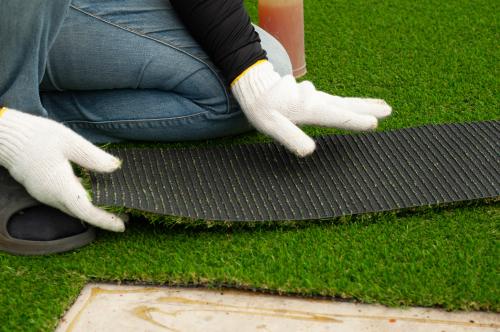Artificial Grass Installation: Common Mistakes
When it comes to artificial grass lawns, there are a few common mistakes which people make when they opt for DIY installation. After all, if you fit your artificial grass poorly you are likely to be lampooned by your peers; why go through all that effort, only to do a shoddy job?
Your garden should be somewhere you are proud to host family and friends, so consider the following advice carefully before starting your DIY installation.
Poor Drainage
Having good drainage for your artificial garden is an extremely important aspect of proper installation. Without adequate drainage, water is not being funnelled away from your artificial turf and you could end up with sitting water every time it rains, or when you break out the hosepipe to water the flower beds. These pools of water can encourage mould, mildew and weed growth which make your artificial garden look scruffy.
If you are suffering from garden puddles when the weather turns and they are refusing to drain after a long period of time, we recommend that you lay a Type 1 crushed concrete base before the sand base. This will help to remove water from the surface and prevent puddles from forming on your artificial lawn.
Uneven Surfaces
Another overlooked aspect of artificial grass installation is uneven surfaces. Though this may sound obvious, professional artificial grass installers will tell you that even the smallest bump, whether it’s a tree root or a stone, will look blindingly obvious on a nice smooth lawn. Make sure that the ground is sufficiently cleared, ideally of the top layer of turf before levelling out with sand, prior to laying your artificial turf.
Unwanted Growth
In addition to uneven ground, weeds and other plants can still grow up through your artificial grass lawn if it is being laid straight down on top of fertile soil. Be sure to install a reliable weed barrier, otherwise, you will be in the slightly odd but mostly time-consuming position of having to weed your fake grass.
Keep an eye out for increased leaf litter during the autumn and pollen during the spring and summer months – leaves, leaf litter and pollen can prevent good water drainage which then causes the organic material to rot, which can be a messy clean-up job.
Hazardous Edges and Joins
A surprising number of people forget to properly secure the edges of their new lawn. If the edges are not secured with the same artificial grass adhesive used to lay the rest of the grass, then they are more likely to fray and curl up at the edge. This can be problematic as not only can loose elements get under the lawn causing damage like perforations and tears, but people are also more likely to trip and injure themselves.
Uneven joins between different rolls of grass should be avoided at all costs. Aside from making the lawn look tacky and poorly installed, they are notoriously difficult and expensive to correct. Don’t forget to lay artificial grass with the pile facing the same way, unless you are specifically going for the “striped” lawn effect. This may not be so obvious up close, but you’ll find it unmissable when you step back to admire your handiwork.
Keeping the Offcuts
After they have completed their artificial grass installation, most people throw away any spare scraps of turf. This may seem the right thing to do but it can actually lead to problems later on. Should you ever need to replace small areas of your artificial lawn, the leftovers will often provide enough spare material to complete the job. However, should you need to replace a larger area, it’s always good to have an example of the lawn handy to enable you to properly match it with ease.

Reflection Free
Finally, although it is not something that will affect the installation of your artificial lawn, many people neglect to remove or create shade over reflective surfaces once they’ve finished their installation. During hot or bright weather, sunlight reflected from mirrored surfaces or double-glazed windows can cause damage or even burn your artificial grass.
Make sure you consider this prior to starting your installation and ensure all reflective surfaces are shaded or covered before you begin – you don’t want to risk your artificial turf melting before you’ve even finished installing it!
Don’t forget to check out our guide on how to maintain your artificial lawn and keep it looking good all year round.
With this list of common mistakes in mind, hopefully, you are better equipped to avoid the same mistakes and correctly install your artificial lawn. If you are still in doubt or you would simply like to enlist the help of an expertly trained team, get in contact with the Artificial Lawn Company for professional knowledge and advice or to enquire about our installation services.
